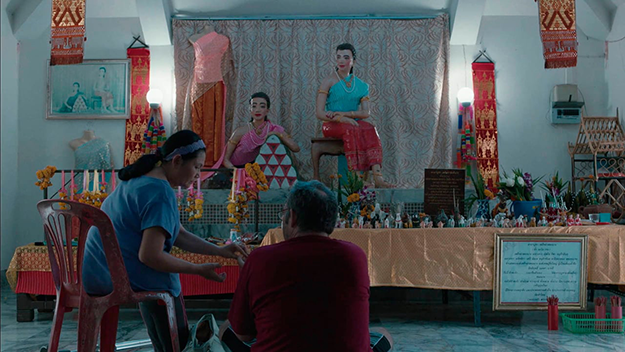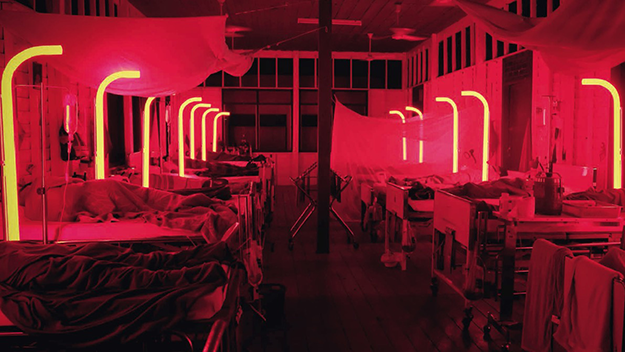Film of the Week: Cemetery of Splendor

Is it acceptable to fall asleep in movies? It’s certainly unavoidable at times, even with the best intentions and fueled by the strongest coffee, so maybe I should ask this question instead: is it acceptable for film critics to joke about falling asleep in movies? British critic Derek Malcolm tells the one about the person who dozes off in a Cannes press show, to find someone tapping their shoulder with the words, “Do you mind not snoring? You’re keeping the rest of us awake.” A certain European director who specializes in long, slow, contemplative work once told me that he sometimes falls asleep in his own movies. My own recent confession: dozing off in Berlin during the fifth hour of Lav Diaz’s A Lullaby to the Sorrowful Memory and struggling to stay awake while semi-hallucinating, addled by festival fatigue and possibly too big a salad at lunchtime. In my defense, the film does have “lullaby” in the title.
Given the oceans of print that have been devoted, since the birth of cinema, to logging the art form’s affinities with the condition of dreaming, it’s strange that sleep itself should somehow have been sidelined in discussions. But let’s not forget the scandalous possibilities of the snooze in the back stalls, as chronicled in the Everly Brothers’ “Wake Up Little Susie”: “The movie wasn’t so hot / It didn’t have much of a plot / We fell asleep, our goose is cooked / Our reputation is shot.” It could be the lament of critics everywhere who have nodded off with a review to file.
Few filmmakers have so directly made the connection between cinema and sleep as Thailand’s Apichatpong Weerasethakul. It’s certainly very easy to drift off in his films’ deep baths of emotion and sense impression, which tend to evoke a state of rapture infused with sometimes comic unease or uncanniness. When I showed his Syndromes and a Century (06) to a group of students recently, the very first response afterward was, “That was super-relaxing”—which seems pretty appropriate. Apichatpong’s films do often induce a curious state of well-being, normally the last thing we expect from art cinema—and nowhere more than in the rain-forest idyll of Blissfully Yours (02), which surely contains the most intensely erotic sound design in all cinema.

A similar feeling suffuses Apichatpong’s Cemetery of Splendor (its Thai title means Love in Khon Kaen, referring to the setting, the director’s home town in Northern Thailand’s Isan region). Inspired by a true incident, the story involves a hospital ward full of soldiers in the grip of a mysterious sleeping sickness. Its heroine is a middle-aged woman, Jen (Apichatpong regular Jenjira Pongpas), who visits the ward as a volunteer carer. She’s a local woman, and the hospital is built on the site of her old elementary school, fond memories of which are rekindled for her. In the ward, she forms connections with a sleeping soldier named Itt (Banlop Lomnoi) and Keng (Jarinpattra Rueangram), a young woman whose supposed psychic powers once brought her headhunting advances from the FBI.
The soldiers are being treated with an unusual method: to soothe their dream-troubled minds, luminous poles are installed by their beds that constantly change color, altering the mood on the ward and making the place look like a curious piece of installation art.
Jen’s rapport with Itt comes to fruition when he wakes after a massage she gives him: his first waking comment is to courteously apologize for peeing so much. Other soldiers wake too, and are soon seen getting haircuts and enjoying canteen meals—although one promptly flops right down again in his food bowl (“It’s not your bedtime yet,” chuckles one of his peers). Most of the soldiers, Itt included, seem to drift in and out of sleep, regularly winding up back in bed—which is after all a condition afflicting all of us from day to day. At one point, Itt and Jen go to the cinema where they see a trailer for a manic-looking Thai horror movie involving a rubber-limbed she-demon: soon after, Itt is carried out of the multiplex, fast asleep.

There’s a reason for the sleeping sickness, we later learn. It seems the hospital is built on the site of a palace where kings were buried thousands of years ago: in another world, the kings are still waging war, and are drawing on the energies of the soldiers to do so. The soldiers will therefore never wake, it seems—which perhaps can be read as a pessimistic comment on Thailand’s inability to emerge from its current conflicts, both external (strained relations with bordering countries) and internal. The latter stresses relate to the state of a nation that has been ruled by a military junta since a coup d’état in May 2014. Only a certain amount of this reality is visible on the surface of a film which seems gentle, calm, at moments almost beatific—but as Thai critic Kong Rithdee puts it, “Apichatpong’s films always hum with subversive tension that exists just beneath their calm appearances . . . and this friction between tranquility and anxiety, between bliss and pain, is a textural element that gives his work a rarefied beauty.” Here’s Kong’s Cinema Scope article on Cemetery, an insider perspective teasing out the film’s political allusions.
A theme central to Apichatpong’s work is that of the secret world hidden behind the visible one, whether historical, political, or metaphysical. What Apichatpong gives us in Cemetery is the sense of an immediate magic that dispenses with special effects (as used in 2004’s Tropical Malady and 2010’s Uncle Boonmee…) to more directly address the imagination—to make us re-imagine what’s in front of our eyes. In one scene, Jen visits the shrine of two princesses, represented as plaster figures. Shortly afterward, she’s sitting eating a bag of longkong fruit, when two young women come and join her at her table. They matter-of-factly introduce themselves as the princesses from the shrine, and give her the backstory of the hospital and the palace, privileged information from the beyond. Jen listens to them, barely surprised—and calmly offers them her fruit to share. Later, she and Keng walk through the palace of the past—which is completely invisible to us. But it’s left to our imagination to see the sink of Burmese jade that Keng tells Jen about, where apparently there are only dry leaves in a wood.
It’s sweet, simple, potent theatrical magic—but it all signals, as so much does in the film, how much the past is visible in Thailand’s present, and how much is invisible unless we’re willing to look. It’s a theme subtly suggested in the image of the tree in the palace/wood, marks on the trunk showing where flood waters once rose to; the same theme is more comically shown in the looming presence of a large model dinosaur outside a school. As ever, too, this new film is filled with echoes of Apichatpong’s previous work, but differently inflected. The end of Syndromes, with its glimpses of social activity in a park, seemed to invoke the euphoric possibility of a shared utopia. Here too Apichatpong ends with an exercise class dancing to bouncy pop, but now the joy isn’t quite so evident, possibly underwritten by allusions to the national “Happiness” campaign organized by the Royal Thai Army a month after the coup, involving free food and dance—at the very least, an intense, coercive PR initiative. The dancing here is overlaid with Itt’s voiceover recounting a baleful vision—“A mountain of bricks, devouring the sun”—before we end with Jen staring into space, glassy-eyed, possibly horror-filled, like a woman who has seen too much.

Apichatpong is a realist of a very particular sort, and you could well see it as a political stance to infuse the seeming mundanity of ordinary citizens’ everyday lives with a heightened tenderness that’s somewhat magical: it’s simply a matter of dignity. He is a great artist of the matter of fact: his films are always about people going about their daily business, even if that business leads them into strange places (never stranger than in the sequence of the void, the “black sun,” discovered in the hospital basement in Syndromes). His characters have a pragmatic, quietly amused attitude to sex: hard-on jokes seem gentler, more benign, more down to earth in his films than anywhere in cinema. With three women at his bedside, Itt lies asleep with a hard-on pushing up through his sheet. “Do you want to try and touch it, Jen?” asks the nurse on duty. Jen calmly declines: “I’ve touched way too many penises in my life.” (Keng nevertheless has a go, and finds it amusingly springy).
Apichatpong finds the extraordinary in the ordinary, which is effectively to say that his films are poetic, always rich in potential (but downplayed) symbolism: at one point, he cuts from the blades of the hospital’s ceiling fan to the whirring blades of a water mill, which seem to betoken energy, repetition, eternal return. But he can go for more overt magic too, notably in the film’s strangest moment, one that seems to come out of nowhere: the CGI image of an amoeba floating across a bright blue sky seemingly reflected in water. Then there’s the typical sensuousness of the multi-layered sound design: crickets, bird calls, traffic, machinery, Big Ben chimes on the radio. It’s this density of the concrete complexity that gives Apichatpong’s world the all-important air of the tangible, creating a real space for his magic to breathe in.
Remember the film’s other title: Love in Khon Kaen. Inspired by Jenjira Pongpas’s own life, Apichatpong places her character at the center of a love story that bewitches in its complexity—a complexity you might elsewhere describe as “perverse,” though here its innocence makes that epithet quite inapt. For this is a story of a disabled late middle-aged woman falling in love with a younger man to whom she has a distinctly maternal relationship—she refers to him as her “new son”, and addresses him as “young pup.” But when Jen goes walking through the past with Keng, we realize that the younger woman is speaking with Itt’s voice. Their forest idyll ends with Itt, in the body of Keng, kneeling to kiss, or lick, Jen’s malformed leg: as complex, and touching, an example of sexual healing as you could hope to see in cinema. Soon after, Jen sits by Itt’s bedside and says to him: “You’re right. This is a good place to sleep.” But we emerge from Cemetery of Splendor thinking: to sleep, perchance to dream, and to dream, perchance to be lucidly awake.
Jonathan Romney is a contributing editor to FILM COMMENT and writes its Film of the Week column. He is a member of the London Film Critics Circle.






